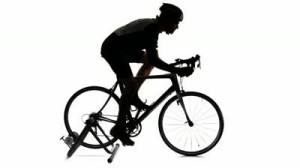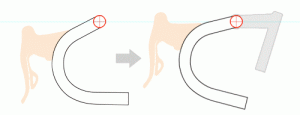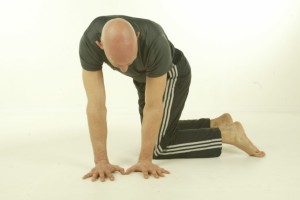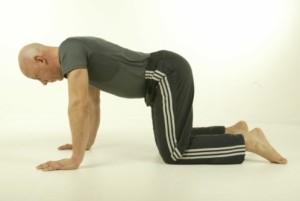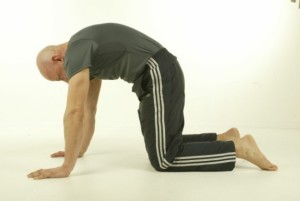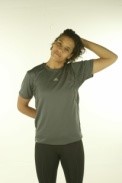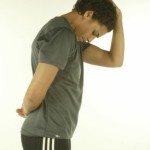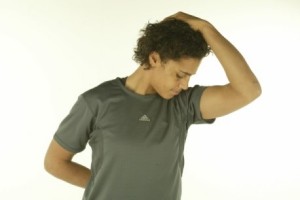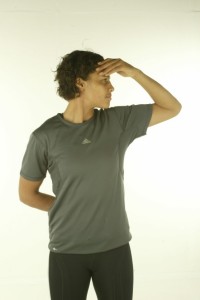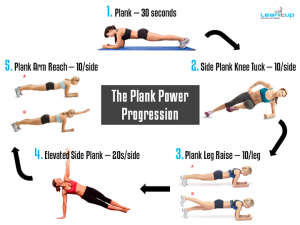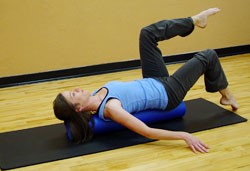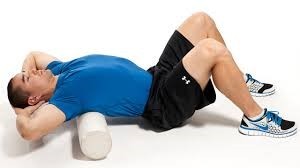Whether you’re starting out or have spent hours in the saddle it’s likely you will or have experienced neck pain at one time or another. The question is why does this occur and what can we do to elevate it?
Fundamentally the human anatomy is not designed for cycling. We have evolved to stand and move on two feet in an upright position with our spine and neck acting as a shock absorber. So immediately we mount a bike our anatomy is compromised.
If you examine the image above you see the cyclist has a forward curvature of the spine (Kyphosis) and, in order to look forward, hyper-extension of the neck – you begin to see why neck pain can occur!
In this position musculature within the upper back, neck and shoulders is driven to work harder to support the imbalanced weight of your head (approx 4.5 to 5kg).
Some of the weight of your upper body is supported through your arms onto the handlebars but even this load can create muscular tension.
We have all seen riders with their shoulders around their ears and arms locked out! All issues which add to the mix.
So what can you do about it?
We discussed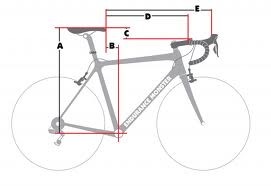 previously the importance of professional bike fittings in minimising injury potential. So now let’s look more specifically at the areas which may help relieve neck pain.
previously the importance of professional bike fittings in minimising injury potential. So now let’s look more specifically at the areas which may help relieve neck pain.
Front end length and height relative to the saddle (E, D, C) are the main considerations in set-up, assuming correct frame size and saddle position (we’ll cover this in detail next time).
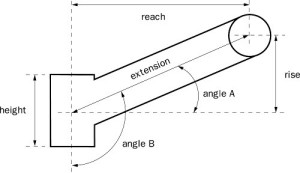
There is of course no one size fits all position – there are too many variables in individual anatomy and ride requirements, from aggressive racer to holiday tour riding. So when making adjustments to your riding position make them small and incremental, test them over a week or two and correct them where necessary.
First let’s look at length. Front end length (reach) reduction or increase can be achieved by altering the headset length (extension) and/or angle (angle A).
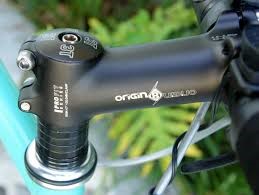
The second consideration is handlebar height, which can be increased or decreased with the addition or removal of headset spacers.
Thirdly, handlebar type and brake hood position can play a part in poor set-up. Consider optimum handlebar width to be in-line with your shoulder width, unduly large or small bars will also impact the loading into the upper back, neck and shoulders. Brake hoods can offer support in the neutral riding position but incorrectly positioned they will influence the front end length, height, support and reach as previously discussed. Be sure not to set them too high, making braking on the drops unsafe.
The mechanical changes to front end set-up discussed are relatively straight forward requiring minimal equipment or expertise. However if you are unsure talk to your local bike mechanic.
Finally, try to remain relaxed in your riding position, neck, shoulders, arms and grip soft. Over a long ride you will drift away from this position so check yourself every now and then.
From an exercise perspective the occurrence of neck pain can be minimised through effective strength, stability, flexibility and mobility training through the whole spine. Remember to think about the muscular skeletal interconnections generating the stresses.
MOBILITY:
1. Side Flexions – Walking around on hands
2. CAT Spinal Flexion & Extension
3. Flexibility
– Lateral Flexion
– Forward Flexion
– Rotational forward Flexion
– Rotation
4. Stability (core strength):
As you can see there are numerous versions of the plank and its progression. The key thing to remember is alignment, visualise a straight line from your ankle through your knee, hip, on up into you shoulder and neck. Any sag or elevation in the midline and you will have lost the hold.
The Roller is also a useful tool in developing spinal mobility and stability, it has endless uses in self-treatment and is a valuable tool to have in your cupboard. We will revisit the roller throughout my blog.
Regular sports massage will help improve muscular flexibility and function, so source a recommended Sports Massage Therapist or search the Sports Massage Association (SMA) website. Regular treatment is proven to enhance performance and minimise injury.
One final thing I tend to discuss with clients – the eyes. Sounds odd, but your eyes have a broad range of motion which is often neglected. So do try to use the eyes’ range of motion, not just the neck.
Next time I will look at saddle set-up and position, its impact on the various common injuries and what we can do to elevate them. I hope this article has been of some help and you don’t have to worry about neck pain again!
Remember there are numerous resources on the net dealing with the issues above, so take a look. I often refer to https://www.sportsinjuryclinic.net/

